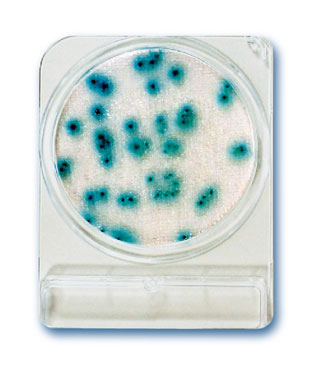Compact Dry YM
- Ready and easy to use portable plate: Preparation of medium is not required, which eliminates waste of medium as well as sterilizing apparatus to prepare the medium.
- Detection of colonies on plate is simple and clear.
- Single colonies on the plate can be isolated for further identification tests
Ready-to-use petri dishes for reliable microbiological analysis for Molds and Yeasts
With Compact Dry YM yeasts and mould can be differentiated by colour development. The medium contains the chromogenic enzyme substrate X-Phos which turns blue with many yeasts. Moulds form fluffy colonies with a characteristic colour. Antibiotics inhibit the growth of bacteria. The Compact Dry YM allows a very good 3-dimension growth of yeast and mould. Compact Dry YM is AOAC approved.
Incubation time and temperature: 3 - 7 days at 25 - 30 °C
Shelf life: 18 months after manufacturing
Storage: Room temperature (+ 1 to + 30 °C)
Sample pretreatment
Viable count in water or liquid foodstuff
Drop 1 ml of specimen (dilute if necessary) on the middle of the Compact Dry plate.
Viable count in solid foodstuff
Add buffer solution to the sample and homogenize by stomacher®. Drop 1 ml of specimen (dilute if necessary) on the middle of the dry sheet of the Compact Dry plate.
Viable count in swab test specimen
Use the swab to wipe the surface, put into the device with wiping solution. Drop 1 ml of wiping solution (dilute if necessary) on the middle of the Compact Dry plate. It is recommended to use “Swab for Compact Dry” offered by HyServe Id-No. 1 002 952/3 (40/240 pieces)
Test instructions
1. Open the cap and drop 1 ml of specimen on the middle of the Compact Dry plate.
2. Specimen diffuses automatically and evenly into the sheet and transforms the dried sheet into a gel within seconds.
3. Put the cap again on the plate and write the information needed on the memorandum section.
4. Turn over the capped plate and put in the incubator.
5. After incubation count the number of colored colonies underneath the plate. White paper placed under the plate helps to count the colonies.
- Compact Dry YM 586502 exp 07.2026.pdf
- Compact Dry YM 576409 exp 02.2026.pdf
- Compact Dry YM 573406 exp 11.2025
- COA-CD-0YM-54054_570404.pdf
- Compact Dry YM 554303 exp 11.2024.pdf
- Compact Dry YM 555305 exp 10.2024.pdf
- Compact Dry YM 545212 exp 05.2024.pdf
- Compact Dry YM 527205 exp 10.2023.pdf
- Compact Dry YM 560309 exp 02.2025.pdf
- Compact Dry YM 567402 exp 07.2025.pdf
